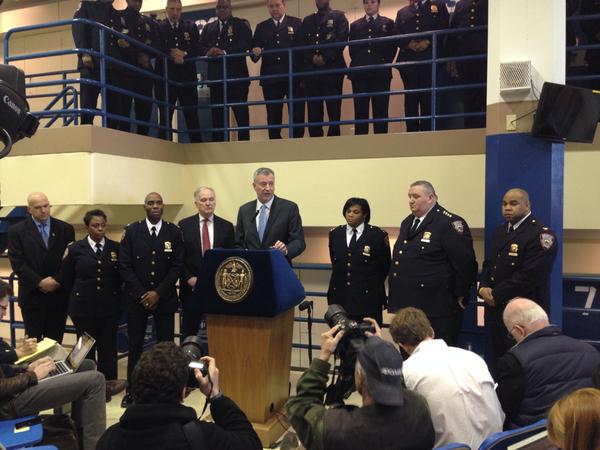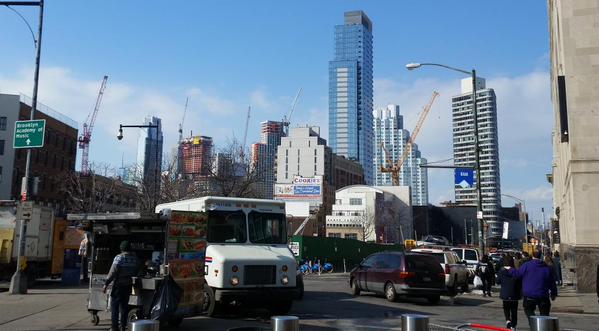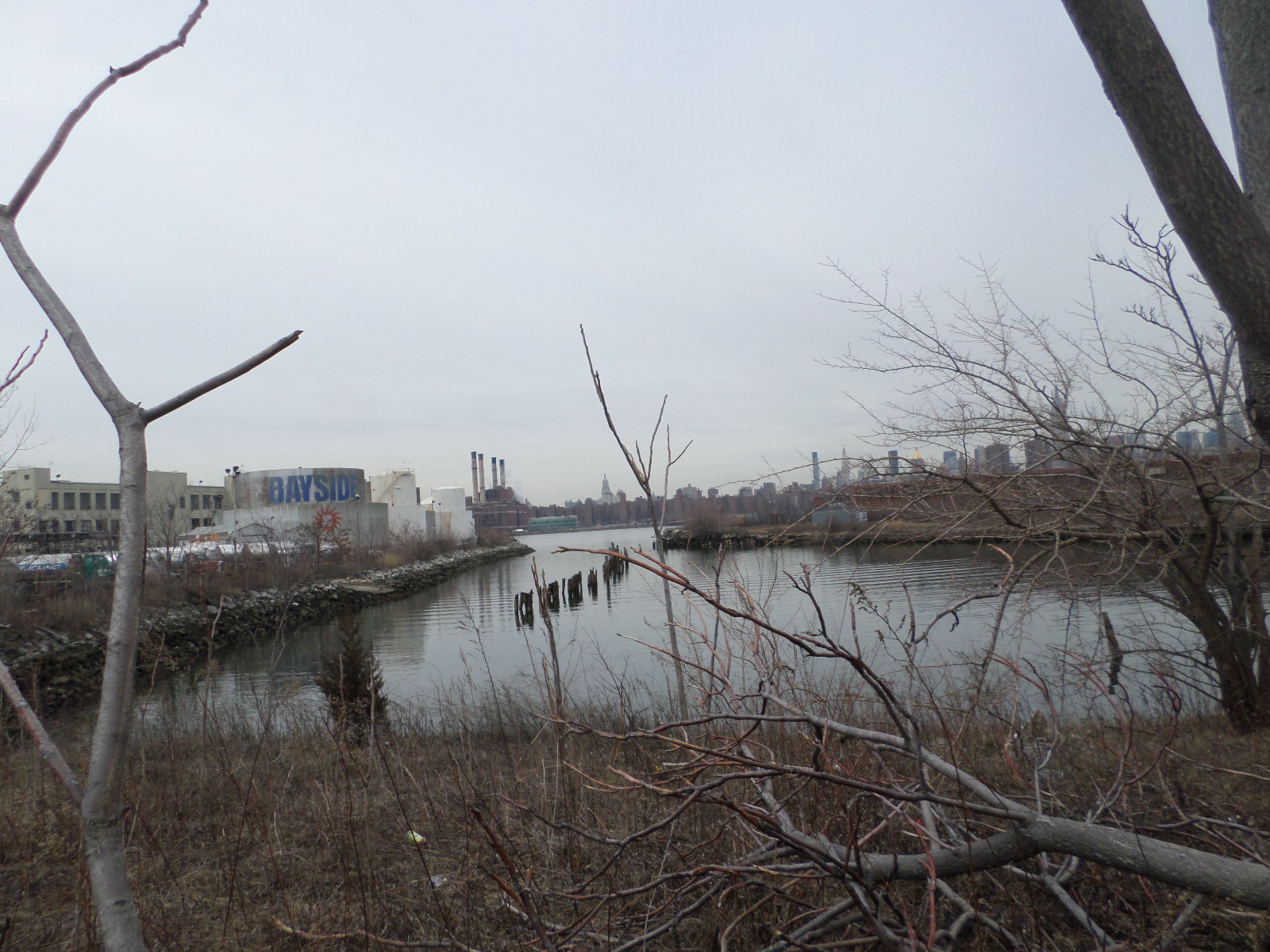Legitimacy of City Land Use Process at Stake in Brooklyn Park Problem
The Bushwick Inlet (photo: Janos Marton)
I think there is zero chance of developers walking away from this waterfront. Look at this view! This is the best view in New York City, maybe in the whole world. You've got the entire Manhattan skyline right in front of you. - Council Member David Yassky (Williamsburg/Greenpoint), 2005
In Williamsburg and Greenpoint, luxury condos have been popping up like mushrooms after the rain. Yet ten years after North Brooklyn was promised a 28-acre park on the East River, that park's prospects seem as remote as ever, in danger of slipping away for good. Recently, neighborhood groups have revived the clamor for Bushwick Inlet Park. At stake is not only greenspace for a community that desperately needs it, but the fundamental legitimacy of the city's land use policy. In 2005, Williamsburg/Greenpoint underwent an enormous rezoning, allowing today's luxury buildings. That rezoning came with a promise from the city, and if the city cannot deliver Bushwick Inlet Park, New Yorkers should not trust the city when it comes to rezone their neighborhoods.
Some New Yorkers think of Williamsburg as a gentrified monolith, but it is full of working class communities that have been there for decades: Polish and Italian on the North Side, Puerto-Rican, Dominican and Hasidic on the South Side. These cultural groups have clashed a great deal over the years, but little has brought them together like waterfront development, long blocked off to all of them by heavy industry.
Activists began organizing around waterfront development in the mid 90s, collaborating on Brooklyn Community Board 1's comprehensive 197-A Plan for the waterfront. A 197-A Plan is the most powerful (though still non-binding) tool under the City Charter for neighborhoods to chart their own long-term development, and this plan recommended large open spaces, public access to the waterfront, mixed use development along Kent Avenue, and a strong commitment to affordable housing. The plan was approved by the City Planning Commission in 2001 and City Council in 2002.
Yet in 2005, when Mayor Bloomberg went all in on his Olympic bid and needed the Williamsburg waterfront for beach volleyball, his administration tossed the 197-A plan in a recycling bin and put forward a whole new rezoning vision for the waterfront rooted in luxury development. The community fought that proposal with everything they had. Elected officials opposed it. People rallied at City Hall. Guerilla activists in costume raised awareness. Articles were written. Forums were held. Multiethnic alliances were forged. TV on the Radio played a show in support of neighborhood activists! You couldn't have asked for better democracy in action.
When modifications were made to the rezoning proposal, some remained upset, but others admitted that the affordable housing, public park and economic development opportunities made the deal a fair one. City Council Deputy Leader Brad Lander, then with the Pratt Center, raved, "The communities of Williamsburg and Greenpoint win because today there is a guarantee of new and permanently affordable housing, instead of a virtual guarantee that new development would price residents out of their homes."
The revised 2005 rezoning, which featured 54 acres of new parkland, including a 28-acre park at the Bushwick Inlet, passed overwhelmingly. To help visualize the promised park, it would be 80% the size of McCarren Park, flank the Bushwick Inlet, and include a beach and boating. North Brooklyn is currently 5% parkland, a third of the city average, is nowhere near a major park, and has one of the lowest open space ratios in the city. If luxury condos were going to change the neighborhood forever, at least the neighborhood would be getting something it needed in return.
The 2005 deal wasn't without its critics, specifically because of concerns that promises to the public wouldn't be delivered. Kimberly Miller from the Municipal Arts Society observed that Jersey City's recent waterfront rezoning had similarly made promises based on private development that never came to fruition. The legendary Jane Jacobs predicted "with utter confidence" that the 2005 plan "will maybe enrich a few heedless and ignorant developers, but at the cost of an ugly and intractable mistake." (Like one developer who built 4,000 waterfront condos after contributing heavily to NY2012, the Bloomberg committee behind NYC's attempt to win the Olympics.)
There's a lot more to this story:
visit Janos.NYC to continue reading
***
by Janos Marton for Gotham Gazette and Janos.NYC
@janosmarton
The Challenge of Cultural Change on Rikers Island

Mayor de Blasio at Rikers (photo: @MonicaCKlein)
After three years of volunteer service, I recently stepped down from the New York City Board of Correction, which is responsible for ensuring that all city jails, including Rikers Island, meet certain minimum standards regulating the care of inmates.
It wasn't the happiest experience I've ever had. While I was on the Board of Correction, Rikers Island became a topic of intense local and national concern. Thanks in no small part to intrepid reporting by Graham Rayman, Jake Pearson, Michael Winerip, Michael Schwirtz and others, there is now widespread agreement that Rikers Island requires significant reform.
One of the statistics we monitored at the Board of Correction is the use of force by correction officers. While I served on the Board, there were a number of horrific incidents where inmates were injured. In several cases, inmates died. Even though I have worked in criminal justice for more than 20 years, I found these incidents shocking and appalling.
On my tours of Rikers Island, I had the chance to meet numerous correction officers. I always sized them up, looking for signs of cruelty. To be honest, what I found more often were signs of compassion. Many (but by no means all) of the correction officers I met expressed real pride in their jobs and real concern for the inmates in their charge. Even in the most horrible of settings – and make no mistake, the jails on Rikers Island are horrible places to be – these officers were capable of small acts of kindness and understanding.
How do we square this reality with The New York Times reports of "medieval levels of violence" meted out with "startling ferocity" by guards at Rikers? Or to ask the question another way, how do we encourage more kindness and less brutality by correction officers?
I have come to the conclusion that the answer is not necessarily more rules or more scrutiny.
In truth, there is no shortage of oversight of Rikers. In addition to the New York City Board of Correction, there is the New York State Commission of Correction, the New York City Council, the media, the courts, and the U.S. Attorney's Office. And this doesn't even begin to list the advocacy groups that keep tabs on what happens on the Island.
Despite all of this, a recent Times headline reported a hard truth: "Even as Many Eyes Watch, Brutality at Rikers Island Persists."
There is an old business adage that "culture eats strategy for breakfast." I fear that the current approach to change on Rikers Island leaves the "deep-seated culture of violence" identified by U.S. Attorney Preet Bharara mostly untouched.
Any effort to change the culture on Rikers must reckon with the deteriorating physical plant, which is beyond antiquated. Even with the reductions in volume that we have seen over the past 20 years, there are still too many people on Rikers – the daily headcount is typically around 10,000 inmates. It is exceedingly difficult to manage this many people humanely in facilities that are falling apart. As the MacArthur Foundation and others have argued, we must explore ways to reduce the number of people in jail, particularly those who are detained pre-trial. And, as former NYC Correction Commissioner Marty Horn has said, we should be looking at options to close Rikers Island and create smaller, county-based facilities with modern amenities (like air conditioning).
Even as we attempt to reduce head counts and improve the physical environment, we should also be having an honest conversation about discretion. A generation ago in the seminal book Street-Level Bureaucracy, Michael Lipsky pointed out that the exercise of discretion is a critical dimension of the daily life of frontline government workers, be they police officers, social workers, teachers, or correction officers.
While we can and should develop baseline standards for correction officers, the truth is that it is impossible to create protocols for every situation that they will experience on the job – no matter how hard we try, there will always be room for officers to exercise discretion, for good or for ill.
Given this reality, we must work harder to create a clearer sense of mission at the Department of Correction. Rules cannot do this. As professor Mark Kleiman (channeling the spirit of James Q. Wilson) has written: "Organizations prize autonomy...Deprivation of autonomy tends to worsen morale and thus performance. The impulse to over-regulate the public sector is a destructive impulse."
In visiting Rikers Island, I never once felt I was in a place of "correction," where the dominant philosophy was one of rehabilitation. To change this will require a significant investment of energy, money, and time. This means taking unglamourous steps that may not yield dividends for years to come, including increasing the salaries of corrections officers, changing the union dynamic, raising hiring standards, investing in research to help promote a learning culture, and giving correction officers a meaningful voice in reform plans as a means of increasing their buy-in.
While many demand immediate change, the reality is that Mayor de Blasio inherited problems on Rikers Island that were decades in the making. We should be realistic about what his administration can accomplish in the short term – and encourage the formulation of a long-term plan that truly changes the culture of the institution.
***
Greg Berman is the Director of the Center for Court Innovation and author of Reducing Crime, Reducing Incarceration: Essays on Criminal Justice Innovation (Quid Pro Books).
***
Have an op-ed idea or submission for Gotham Gazette? E-mail editor Ben Max: This email address is being protected from spambots. You need JavaScript enabled to view it.
Citywide Rezoning Plan Would Benefit Developers, Hurt Neighborhoods

Cranes over Brooklyn (photo: Michael Flynn)
A citywide rezoning proposal quietly released by the de Blasio administration last month has begun the public review process. 'Zoning for Quality and Affordability' sounds like mom and apple pie, as it purports to make new housing less costly and meet higher standards. But a closer examination calls these premises into question. Big real estate, not average New Yorkers, would be the main beneficiary of some of the plan's key provisions, and its cost would be the undoing of neighborhood zoning protections years in the making.
The proposal is quite broad in its scope. But a central element is raising the allowable height of new development in "contextual zoning districts" -- areas where specific height limits and streetwall requirements help ensure that new buildings fit their context. These rules are meant to keep much of the "sore thumb" development we see around the city from cropping up in residential neighborhoods with strongly defined character, from the Lower East Side to Harlem, Crown Heights to Jackson Heights, the Village to Sunset Park.
Many of these height limits took years of effort by local communities to secure, and often involved compromises and trade-offs with the city and real estate interests to attain modest controls.
Now those rules would be upended, with the height caps lifted by as much as 20 to 30 percent, across the board.
As the plan's title implies, the rationale for these proposed changes are improvements in "quality and affordability," but neither seems likely to result from the current plan.
First, in many cases the proposed height limit increases would apply to purely market-rate housing. For example, in one of the more common contextual zoning districts, developers would automatically get to build about 20 percent taller than currently allowed for new luxury development. In the fraction of those districts where developers get more square feet if they reserve 20 percent of the units for affordable housing, there would be an additional 10 percent bump in the allowable height for such construction.
But even the height increase for developments that include 20 percent affordable housing raises serious questions. In existing contextual zoning districts such as the East Village, we have seen affordable housing included in some new developments built with the current, hard fought-for height limits, though not in every one. The City says higher height limits will mean more affordable units built, but the mixed results in places like the East Village don't offer any clear indication that this is so.
Including affordable units is currently optional in these zones, and this plan would not change that. It seems that the optional nature of the program, along with a variety of other factors, have a much bigger impact upon the number of affordable units built, rather than the height limits.
But for argument's sake, let's say raising height limits in contextual zones would increase participation in the 20 percent affordable housing program. Advocates for this approach point to the two areas of the city where significant numbers of affordable units have been produced through this program, West Chelsea/Hudson Yards and Williamsburg/Greenpoint. They have much looser height restrictions on new development and a significant number of their tidal wave of new, luxury developments include 20 percent affordable housing.
At the same time, though, in the ten years since that program has been implemented in those neighborhoods, they have seen a nearly unprecedented rise in rents and housing prices. In other words, in the two cases where this program has been most successful – where we have seen the highest rates of developers choosing to include 20 percent affordable housing in their new developments – we have also seen perhaps the most dramatic overall loss of affordability.
Is this the future we want? And is this not the inevitable result of tying the production of every new affordable apartment to four market-rate, super-luxury ones, which is enshrined in this proposal?
The other rationales for the increased height limits in the plan are equally dubious. The City claims current contextual zoning rules result in flat, boxy buildings; undesirable street-level ground floor apartments; and substandard floor-to-ceiling heights that discourage development. By lifting the overall height of buildings and loosening the contextual zones' streetwall requirements, the City claims more attractive and livable buildings that are cheaper to construct will result.
In fact, while some new buildings in contextual zones are mediocre in design, some are actually quite appealing – it really depends upon the architect and developer. But non-contextual zones, with no height limits or streetwall requirements, routinely see some of the most uninspiring, cringeworthy new designs in the city, poking a big hole in the "less restrictions equals better design" theory.
And as for the notion that current height limits are discouraging development or making for substandard apartments, one need only look at the flood of new construction in contextual zones from Bedford-Stuyvesant to Astoria, Park Slope to the Upper East Side. People are lining up to live there, and developers are making a hefty profit.
But perhaps not as hefty as they would like. Fewer restrictions on height, allowing grander floor-to-ceiling heights and apartments with more commanding views, would fetch developers even higher prices. But it certainly would not make these new apartments more affordable. And neighborhoods would pay the price with less light, air, and sky, and a loss of the character and scale they fought so hard to maintain.
The main beneficiaries of these aspects of the 'Zoning for Quality and Affordability' plan appear to be real estate interests, not those who care about quality design or affordable housing. It's likely no coincidence that these proposed changes are ones that deep-pocketed developers have sought for years. Now, wrapped in claims about quality and affordability, they finally have a chance to get them.
The mayor's 'Zoning for Quality and Affordability' plan is not without good points, and its stated goals are worthy of support. But substantial modifications are needed to protect neighborhood character and benefit average New Yorkers before it can live up to its lofty premise, and before it should be considered for adoption.
***
Andrew Berman is the Executive Director of the Greenwich Village Society for Historic Preservation
****
Have an op-ed idea or submission for Gotham Gazette? E-mail editor Ben Max: This email address is being protected from spambots. You need JavaScript enabled to view it.





